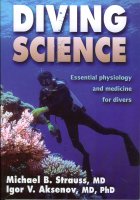 For a good many students in a scuba class, "diving science" means memorizing just enough facts about the gas laws to answer the multiple choice questions in the tests, and perhaps a few other physiological facts affecting the human body underwater. They'll remember to never hold your breath while scuba diving and not to exceed ascend rates or bottom times. However, a few individuals want to know more about the underlying science of diving, and they should read Diving Science by Doctors Michael Strauss and Igor S. Aksenov who are both hyperbaric medicine experts as well as experienced divers.
For a good many students in a scuba class, "diving science" means memorizing just enough facts about the gas laws to answer the multiple choice questions in the tests, and perhaps a few other physiological facts affecting the human body underwater. They'll remember to never hold your breath while scuba diving and not to exceed ascend rates or bottom times. However, a few individuals want to know more about the underlying science of diving, and they should read Diving Science by Doctors Michael Strauss and Igor S. Aksenov who are both hyperbaric medicine experts as well as experienced divers.
Diving Science is sort of a mix between medical textbook and general purpose reading for an interested non-medical audience. The writing style is clear and concise so that it can easily be understood, but it never talks down to the reader. Expect a good share of medical terms and terminology, but everything is well explained and illustrated. The overall purpose of the book is to help divers anticipate, recognize, understand, and react to the physical, physiological and psychological stresses encountered in recreational diving.
Diving Science is organized into three major sections:
The first -- The Underwater Environment -- explains the basics of diving, not unlike what one learns in a diving certification course but with considerably more detail.
The second -- Physiological Responses to the Underwater Environment -- describes in detail how the various parts of the human body react to diving: heart and vascular system, the respiratory system, blood and muscles, and how the body reacts in cold water, how it best moves and orients itself. This section also contains fascinating comparisons betwen human divers and diving mammals. For example, did you know they breathe out before they dive, not in?
The third, and longest, section deals with the Medical Aspects of Sports Diving. That includes medical preparation, fitness and nutrition, and then the numerous potential problems a diver may encounter on the surface, while descending, while at the bottom, and while ascending. This third part reads a bit more like a medical textbook but frequent Bringing it all Together summaries that describe real world scenarios help readers understand.
The book closes with an excellent Diving Medicine from A to Z appendix that concisely describes numerous diving facts, and reference sections on diving organizations, medical texts and manuals, recommended equipment and supplies, a very detailed glossary, suggested reading, and even a list of luminaries in diving medicine.
Overall, Diving Science should be required reading for anyone who wants to know more about the medical and scientific aspects of diving than what is included in the certification class manuals. While there is a lot of medical detail, readers also learn numerous interesting facts and statistics as well as how all this science affects divers in specific real world scenarios. .
-- C. H. Blickenstorfer






